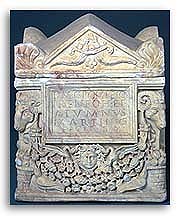 |
|
Death & Burial Like most people living in ancient times, the Romans had a short life expectancy. Diseases were common, and medical knowledge was limited. Funerary rituals and practices played a central role in Roman life because remembering and honoring the deceased members of their family was important to the Romans. |
| Burial Practices |
 |
The Romans practiced two forms of burial: cremation (burning the body) and inhumation (burying the body intact.) In cremation, the ashes of the deceased were placed in urns, like this example from the Carlos Museum. |
| This marble coffin, called a sarcophagus (a Greek word that means "flesh eater"), was used to bury a body intact. Let's look at what the sculptor carved on it. |

|
| Where were people buried?
Burials were placed outside the city walls along the roads leading into the city, probably to keep disease from spreading. Both cremation and inhumation were practiced, but in later times inhumation became more popular. Eventually cemeteries were set aside for these burials rather than placing them along the roads. As land became in short supply, the Romans created underground cemeteries carved from the soft tufa stone around Rome -- they were called catacombs. |
 |
 |
 |
 |
 |
 |
 |
© Michael C. Carlos Museum of Emory University,
Memorial Art Gallery of the University of Rochester and Dallas Museum of Art
For more information please contact odyssey@emory.edu.
Last Update: